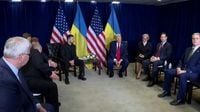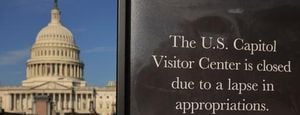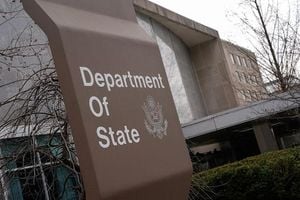Ukrainian President Volodymyr Zelenskyy is set to make a high-stakes visit to Washington, DC, this week, aiming to secure critical military and energy support from the United States at a pivotal moment in Ukraine's war with Russia. The trip, announced on Monday, October 13, 2025, comes amid escalating Russian attacks on Ukraine’s infrastructure and follows a series of tense exchanges between world leaders over the potential provision of long-range U.S. weaponry.
Zelenskyy confirmed he will meet with U.S. President Donald Trump at the White House on Friday, October 17, 2025, a meeting that Ukrainian officials and Western diplomats have described as crucial for the country’s defense posture. According to the Associated Press, the Ukrainian leader said, “The main topics will be air defense and our long-range capabilities, to maintain pressure on Russia.” He emphasized the urgency of bolstering Ukraine’s security, especially as winter approaches and Russian forces intensify their bombardment of electricity and gas networks.
The Ukrainian delegation, already en route to the U.S., includes Prime Minister Yulia Svyrydenko, Head of the Office Andriy Yermak, Secretary of the National Security and Defense Council Rustem Umerov, and several diplomatic representatives. Zelenskyy’s agenda is packed: in addition to his summit with Trump, he plans to meet with defense and energy companies, as well as members of Congress. These meetings, he noted, are necessary in light of “various forms of attacks” on Ukraine’s infrastructure, and are part of a broader strategy to ensure his country is prepared for all contingencies.
The visit follows what Zelenskyy described as a “very productive” phone call with Trump over the weekend, during which the two leaders discussed military support and possible steps toward ending the war with Russia. The Financial Times reported that the upcoming face-to-face meeting was preceded by two such calls, underscoring the urgency and complexity of the current moment.
The central—and most controversial—issue on the table is the potential U.S. provision of long-range Tomahawk cruise missiles to Ukraine. President Trump, speaking to reporters on Air Force One as he traveled to the Middle East on Monday, suggested he was weighing this option as a means of pressuring Moscow to settle the conflict. According to NBC News, Trump stated, “We’ll see... I may. I might say, ‘Look: if this war is not going to get settled, I’m going to send them Tomahawks.’” He added, “The Tomahawk is an incredible weapon, very offensive weapon. And honestly, Russia does not need that.”
Such a move would mark a new level of U.S. involvement in the conflict. As reported by Sky News and other outlets, Trump acknowledged, “We may not, but we may do it. I think it’s appropriate to bring up — yeah, I want to. I want to see the war settled.” The Tomahawk missile, known for its precision and range, would give Ukraine the ability to strike deeper into Russian territory, a capability that could shift the dynamics of the war but also carries significant risks.
The Kremlin has responded with alarm. Russian President Vladimir Putin has warned that the supply of long-range U.S. missiles to Ukraine would represent a “qualitatively new stage of escalation, including in relations between Russia and the U.S.” Dmitry Medvedev, a top Russian official and former president, went further, cautioning that the delivery “could end badly for everyone, and first and foremost, for Trump himself.” Moscow’s “extreme concern” over the Tomahawk issue has only heightened the stakes of this week’s diplomatic engagements.
The timing of Zelenskyy’s trip is especially sensitive. In recent weeks, Russia has ramped up attacks on Ukraine’s critical infrastructure, targeting power plants and gas facilities in an apparent effort to cripple the country’s energy grid ahead of freezing winter temperatures. According to Ukraine’s State Emergency Service, the most severe attacks on Monday occurred around the Black Sea port of Odesa and in the northern Chernihiv region, resulting in at least one fatality. The relentless bombardment is widely seen as a campaign to erode public morale and force Kyiv into concessions.
During a meeting with the European Union’s High Representative for Foreign Affairs, Kaja Kallas, Zelenskyy stressed the importance of U.S. assistance in protecting Ukraine’s energy networks. Kallas, for her part, pledged continued pressure on Moscow and expressed confidence that the EU would overcome internal objections to a new package of sanctions against Russia. “On funding, the needs are enormous. We must help Ukraine defend itself so we don’t later spend even more repairing destroyed infrastructure,” Kallas said. She acknowledged the slow pace of EU decision-making but remained optimistic: “We are 27 member states, and 27 democracies, so debates take time ... I’m positive that, as before, we’ll achieve a decision.”
The current visit also comes on the heels of Trump’s own trip to the Middle East, where he was praised for brokering a peace deal that led to the release of Hamas-held hostages and the return of Palestinian prisoners by Israel. As reported by multiple outlets, this diplomatic success has added to the sense of momentum—and scrutiny—surrounding his administration’s foreign policy.
In the background, other diplomatic efforts continue. According to Ukrainian officials, the high-level talks in Washington are aimed at “strengthening Ukraine’s defense, securing our energy resilience, and intensifying sanctions pressure on the aggressor.” These goals reflect the overlapping military, economic, and humanitarian challenges Ukraine faces as the war grinds on.
The relationship between Trump and Zelenskyy has been marked by both cooperation and tension. Zelenskyy last visited the White House in mid-August 2025, shortly after Trump met with Putin in Alaska—a meeting that drew international attention. During the 2024 campaign, Trump claimed he could end the war in Ukraine quickly, even within 24 hours, but has since acknowledged the complexity of the situation, saying, “Putin let me down.”
The humanitarian dimension of the conflict also remains in focus. First Lady Melania Trump has reportedly maintained an “open channel of communication” with Putin concerning Ukrainian children believed to have been taken to Russia. In a letter penned in August, she called on Putin to protect “the innocence of these children,” adding a personal and emotional layer to the ongoing diplomatic efforts.
As the world watches, the outcome of Zelenskyy’s visit to Washington could have far-reaching implications—not only for the future of Ukraine, but for the broader balance of power in Europe and beyond. The decisions made this week, from missile provisions to sanctions and humanitarian aid, will reverberate across capitals and battlefields alike.
The stakes could hardly be higher as both leaders prepare for what may be their most consequential meeting yet. The world now waits to see whether diplomacy, deterrence, or escalation will define the next chapter of the war in Ukraine.






